Sheffield United were considered as obvious contenders for relegation by many football fans before the start of this Premier League season. Without any major signings, the squad consisting of players who played in Championship was seen as not up to par to the standards of a top-tier division of English football. However, against all odds, due to the unique playing system and great chemistry between the players Sheffield United are currently sitting in the seventh position. The win in the next game would take them to a Champions League spot. The way the club is viewed changed drastically throughout this season, going from the hopes of not getting relegated back to the Championship to the famous chant “We’re playing in Europe next season”. Their understanding of total football and positional rotations with overlapping centre-backs, wing-backs taking the positions of wingers and forwards dropping deeper into midfield positions can be called exceptional. In this tactical analysis in the form of a scout report, I will look into their uncommon attacking and defensive principles that amazed so many football fans and got them to where they are today.
Formation and personnel
Sheffield United are using a formation with three centre-backs and two wing-backs as well as a midfield three with Oliver Norwood playing the deepest role of the three. Chris Wilder changed the midfield shape for the Premier League, and Sheffield is playing with an “inverted triangle” with John Fleck and John Lundstram in a more advanced, box-to-box role, supporting the wing-backs and overlapping centre-backs in the wide areas. The two forwards positions is where the most competition happens, with Chris Wilder sensibly rotating between the four players – Sharp, Mousset, McGoldrick and McBurnie, all getting regular minutes this season.
The productive winter transfer window saw Sheffield welcome a couple of new-comers in the likes of former Genk’s midfielder Sander Berge, the forward Richairo Zivkovic and the right-back Panagiotis Retsos on loan from Bayer Leverkusen. While the last two haven’t been given a real chance to show their talents, Berge has been regularly featuring since his arrival at Bramall Lane.
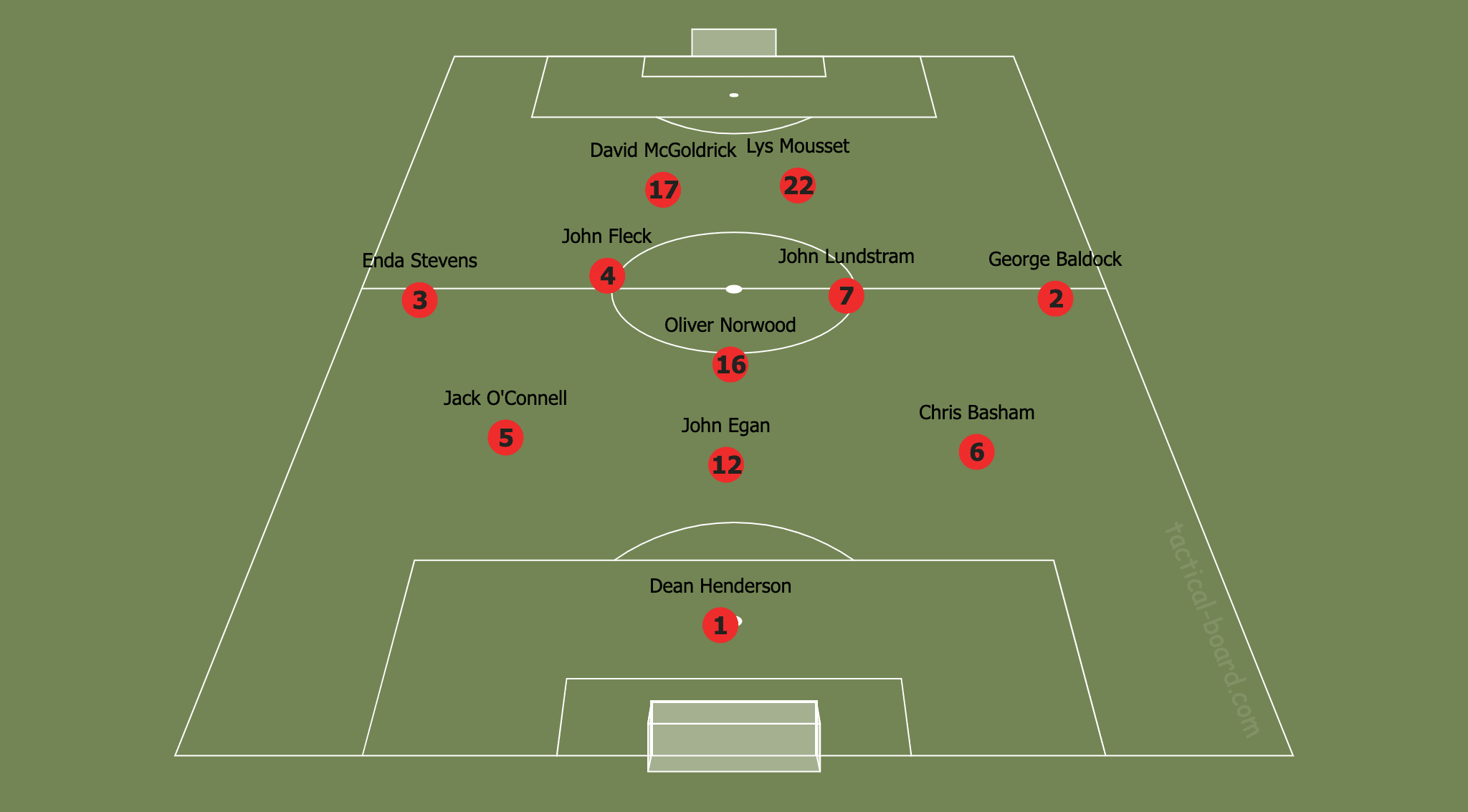
In the image above you can see one of the variations of Sheffield United’s line-up. The back-three with both wing-backs have all started every single game for Sheffield in the Premier League, with the small exception of John Egan missing out on one game due to injury. However, midfield and attack can have some variations, as we saw with the variety of options with the two striking positions. Regarding the midfield, Luke Freeman and Sander Berge in the latest matches rotated for Lundstram and Fleck. Wilder has his set of players that he trusts to play in almost every game, but this season there has been a lot of rotation regarding midfield and attack. Although the players in the system sometimes change, the roles of these positions remain the same, and whoever was taking the position in a particular match, all of them have been doing a great job.
Build-up structure
Sheffield United use the 3-5-2 in possession, with the trio of centre-backs in the first line. Most of the time one of the wide centre-backs, O’Connell or Basham, go wide while the wing-backs push up further. If the opposition team has one striker, the two remaining centre-backs (for example, Egan and O’Connell) remain in the first line, while Norwood stays right above them in the midfield. However, this very much depends on the match and the opposition structure. If the opposition team has two strikers or applies high-intensity pressure, then Norwood can drop into the backline, replacing Basham or O’Connell to direct attacks from there, creating superiority in numbers or at least equaling it. However, in some cases either one of the other two midfielders can drop deep too, like in the example below Lundstram is creating a back-three with Egan and O’Connell:
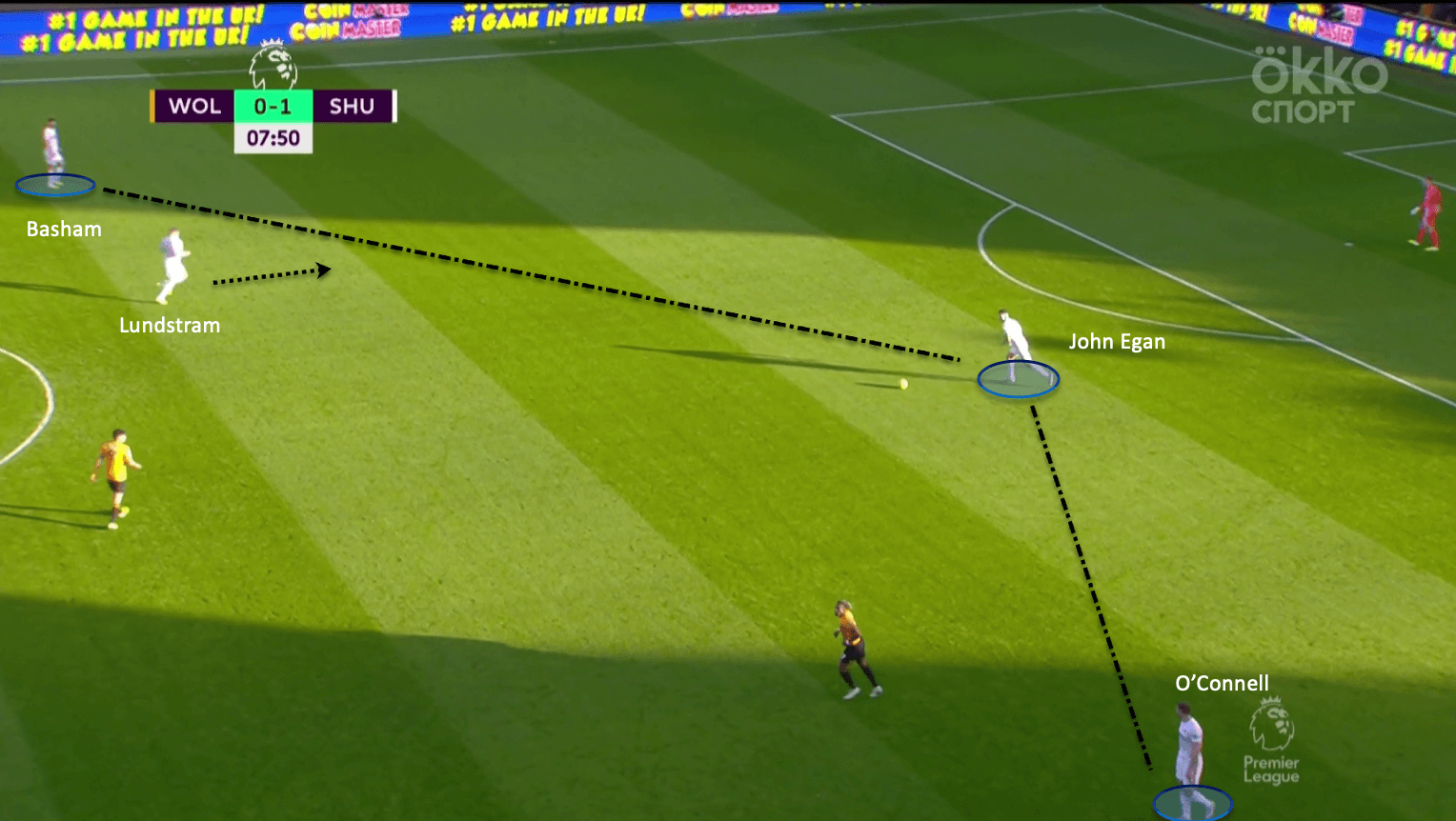
Sheffield tends to direct attacks down the flanks right away or to get the ball there through Fleck or Lundstram. Through the well-drilled movement of the players, they are able to easily create overloads on the flanks, and attacking through the wing- and half-spaces is the main way for Sheffield to enter the final third.
Below you can see an example of attacking through the wings, with Lundstram positioning between the lines and getting a pass from Egan and then getting it to O’Connell (who is right around the touchline). After receiving the pass, O’Connell can advance further with the help of both Lundstram and Fleck, as Sheffield have the obvious superiority in players(3v2), so a one-two or a third-man run is an option.
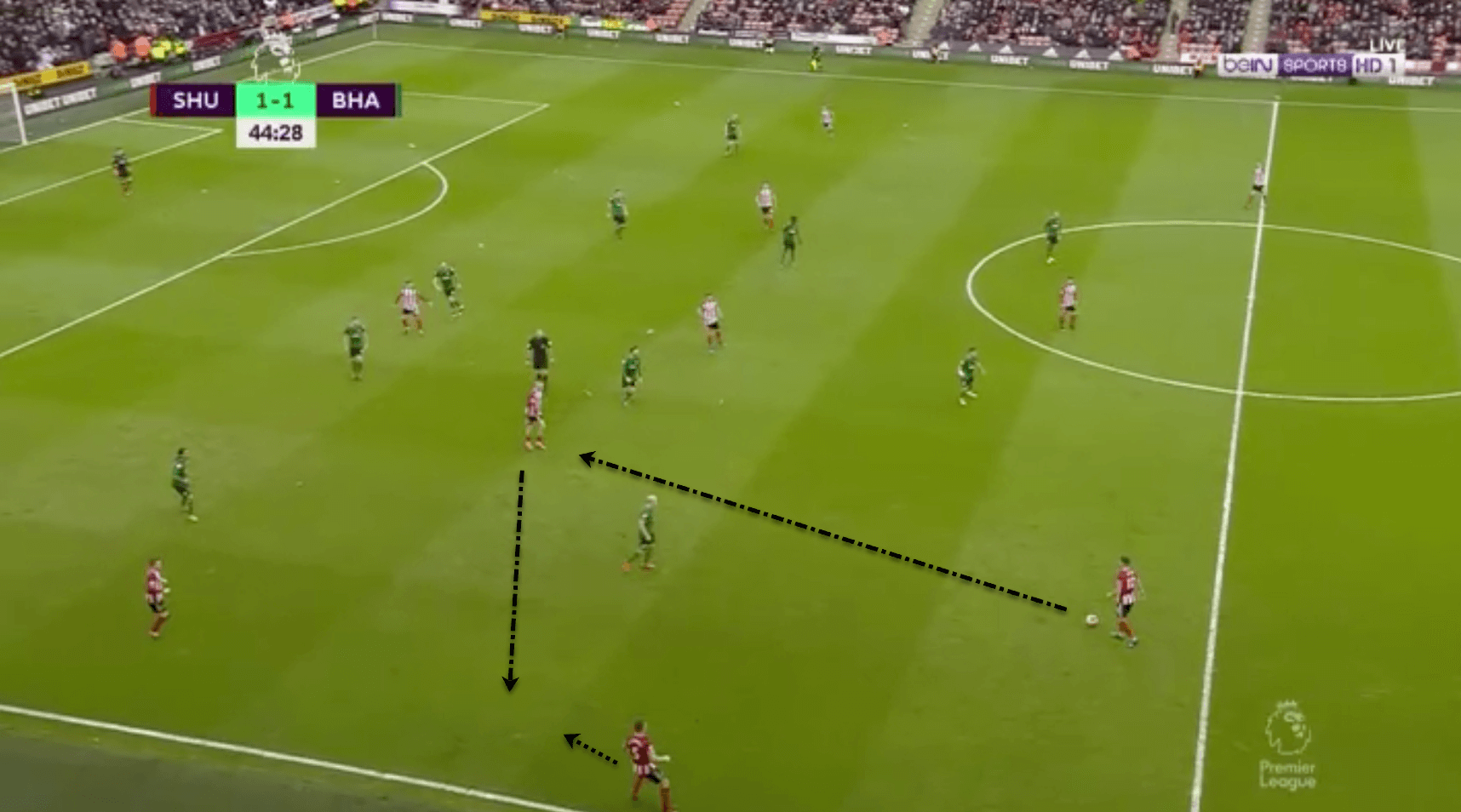
When Stevens or Baldock get the ball on the flank, one of the centre-backs pushes higher and overlaps the wing-back. Then the wingback goes vertically higher and plays in a half-space. Plus one of the midfielders comes shorter to provide one more passing option. This movement isolates the full-back and he can get outplayed very easily. Even if the opposition has two or three players, the involvement of the midfielder, wing-back (or centre-back, depending on the specific situation) and sometimes one of the strikers gives the player on the ball multiple options.
Below you can see an example of that movement as O’Connell is on the flank and Stevens is playing in the half-space. Fleck is positioned a little bit deeper, and you can see that Sheffield have four players on the one side of the pitch, with McGoldrick drifting wide as well. This allows them to dictate play from this area, make passing combinations because of triangles in wide areas (wing-back, overlapping centre-back, midfielder and/or striker), and penetrate opposition defences on the flanks.
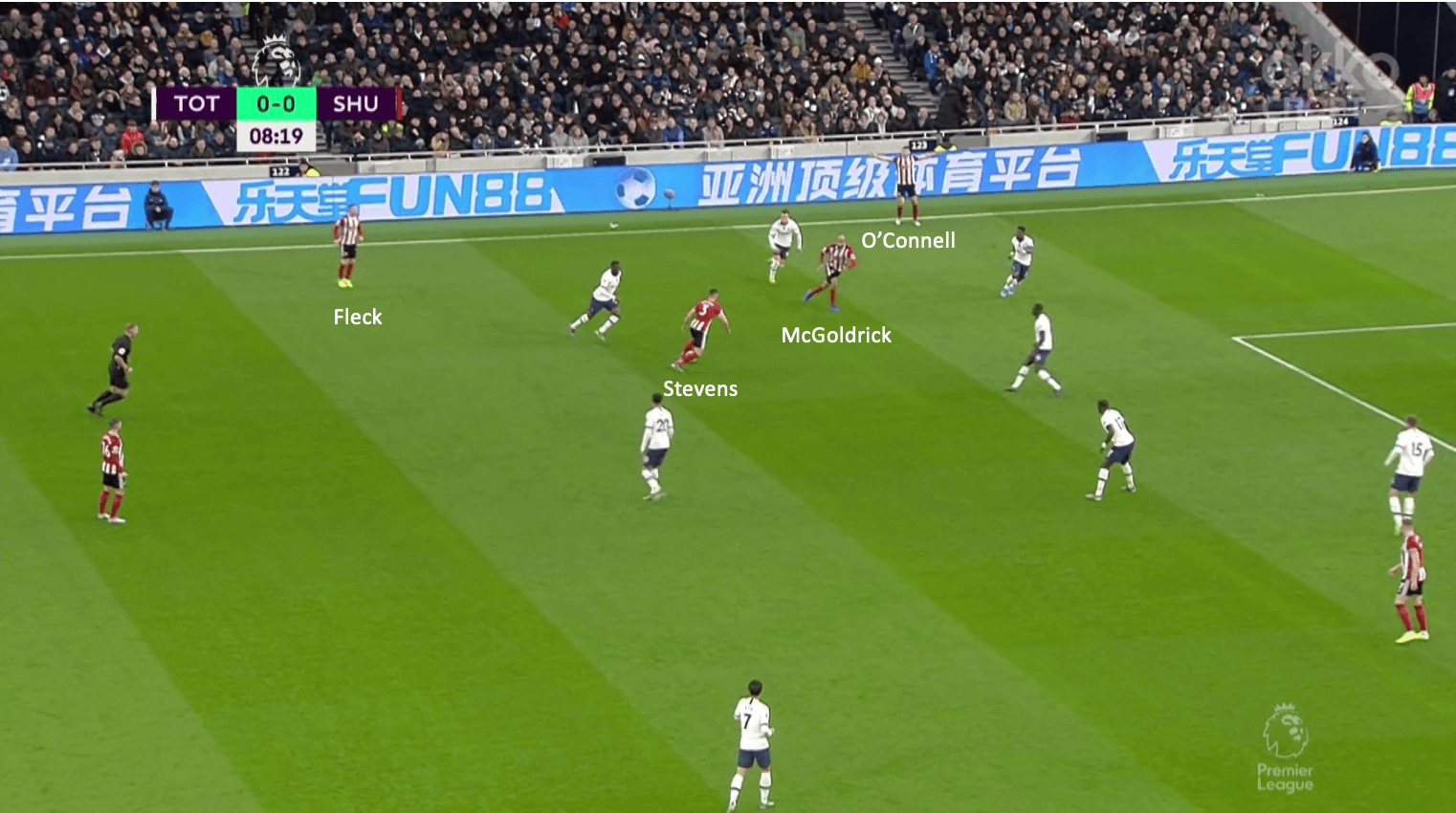
In the next section of this analysis, I will look into the principles of play when they advance to the final third and the player’s movements that make the constant endangerment of the 18-yard box possible.
Attacking patterns
As we saw previously, Sheffield United creates overloads on the flanks and primarily attacks through this area. The main goal is to get the ball into the zone behind the opposition backline (or at least the zone behind the full-back).
Chris Wilder instilled several patterns to make that happen. First of all, creating overloads on the flanks and then making one-two’s or third-man runs to get behind the defensive line. Secondly, it is overlapping (or sometimes underlapping) centre-backs to provide width, to create depth to run into the zones behind the defence, and again, to create numerical superiorities. Thirdly, it is the forwards that make wide runs between the full-back and centre-back. And the last one is switches of play from one flank to another. This is the most effective when one flank has already been overloaded.
Let’s start with the third option, runs made by forwards in the pockets between the full-back and the centre-back. This kind of run is very difficult for the opposition defence, as it is hard to track the movement of two forwards. In the image below you can see an example of that movement. McGoldrick gets behind the defence, running into the space between the two defenders, and then makes a low cross that eventually is converted by Lundstram. In this example we can see another important principle applied by Wilder: the midfielders and wing-backs are entering the penalty area and particularly targeting the far post in their runs. Fleck is running into the space between the centre-backs, Mousset takes the attention of the far centre-back and full-back, so Lundstram is left completely alone.
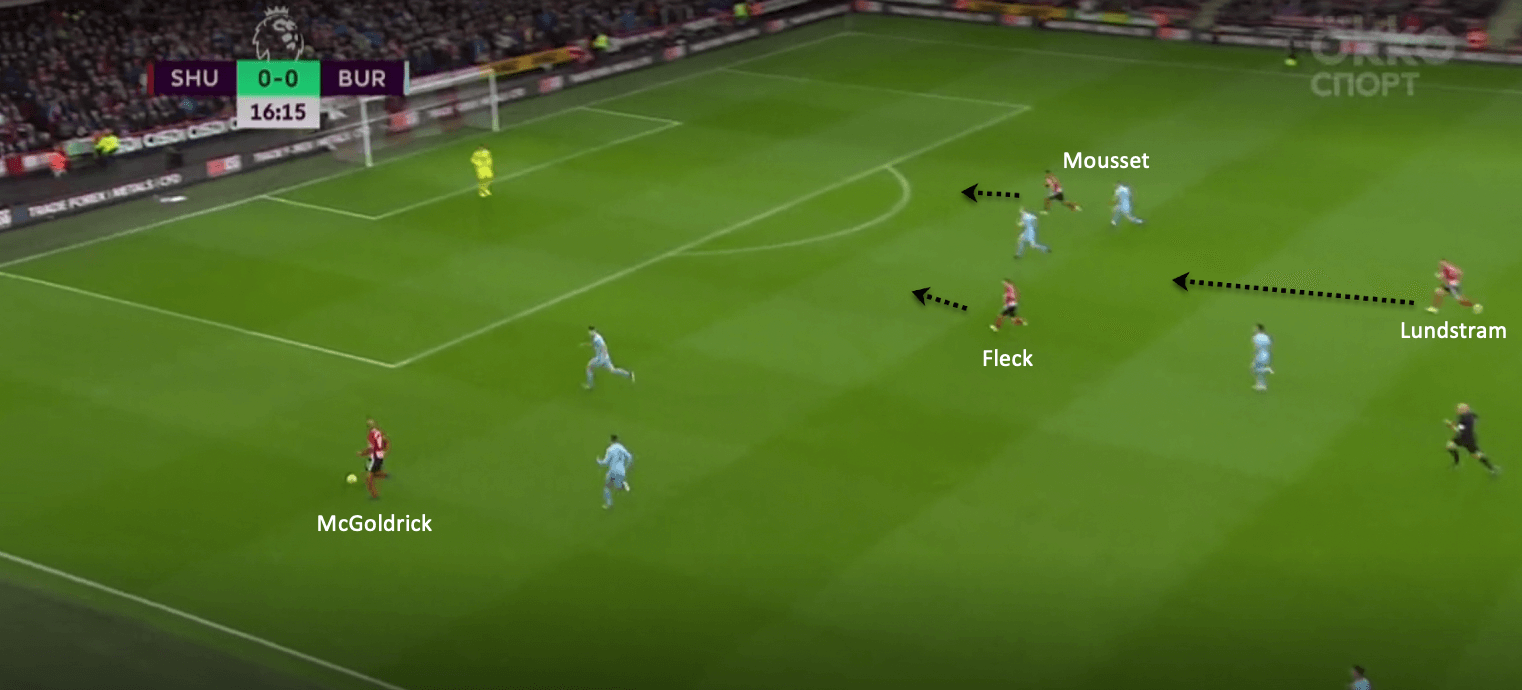
Midfielders always support the attack with these runs, and so do the wing-backs (and sometimes centre-backs). For example, if the overload is happening on the left flank, then it is very probable that Baldock will be on the far post in the moment of a cross. Basham can take that role too, and he is 6’2 feet tall, and his involvement in the final stages of attacks makes perfect sense. Two forwards usually occupy the far post as well (although there are variations). Crosses themselves can be directed towards the far post, near post, in the centre of the 18-yard box. Sheffield is practising both normal crosses and low (whipped) crosses. With McBurnie (6’1), McGoldrick (6’0), Mousset (6’0) and Sharp, who was one of the best in Championship regarding the play in the box – the reliance on crosses during attacks becomes justifiable.
I will look into the first and second patterns together, as they are very similar and often interconnected. As I mentioned before, Sheffield is keen on attacking through the flanks, both half- and wing- spaces. If they start an attack on one flank, they will try and work around the attack until the end on the same side of the pitch. I already mentioned a couple of times that this team uses overloads and positional rotations in the build-up and during the full attacking stage.
The involvement of Basham and O’Connell in the attacks have several reasons.
Firstly, one of the centre-backs participating in the attack in the final third helps equal or outnumber the opponents on the flank.
Secondly, when the centre-backs identify the space in the opposition’s defensive set up, they will make runs right into that space. Both Basham and O’Connell are strong runners with good dribbling ability, so it makes sense for them to make use of opposition’s bad positioning.
You can see both reasons in the example below, where Basham identifies the gap in the half-space and makes a run. Moreover, his movement equals the number of Sheffield and Tottenham players on the right flank.
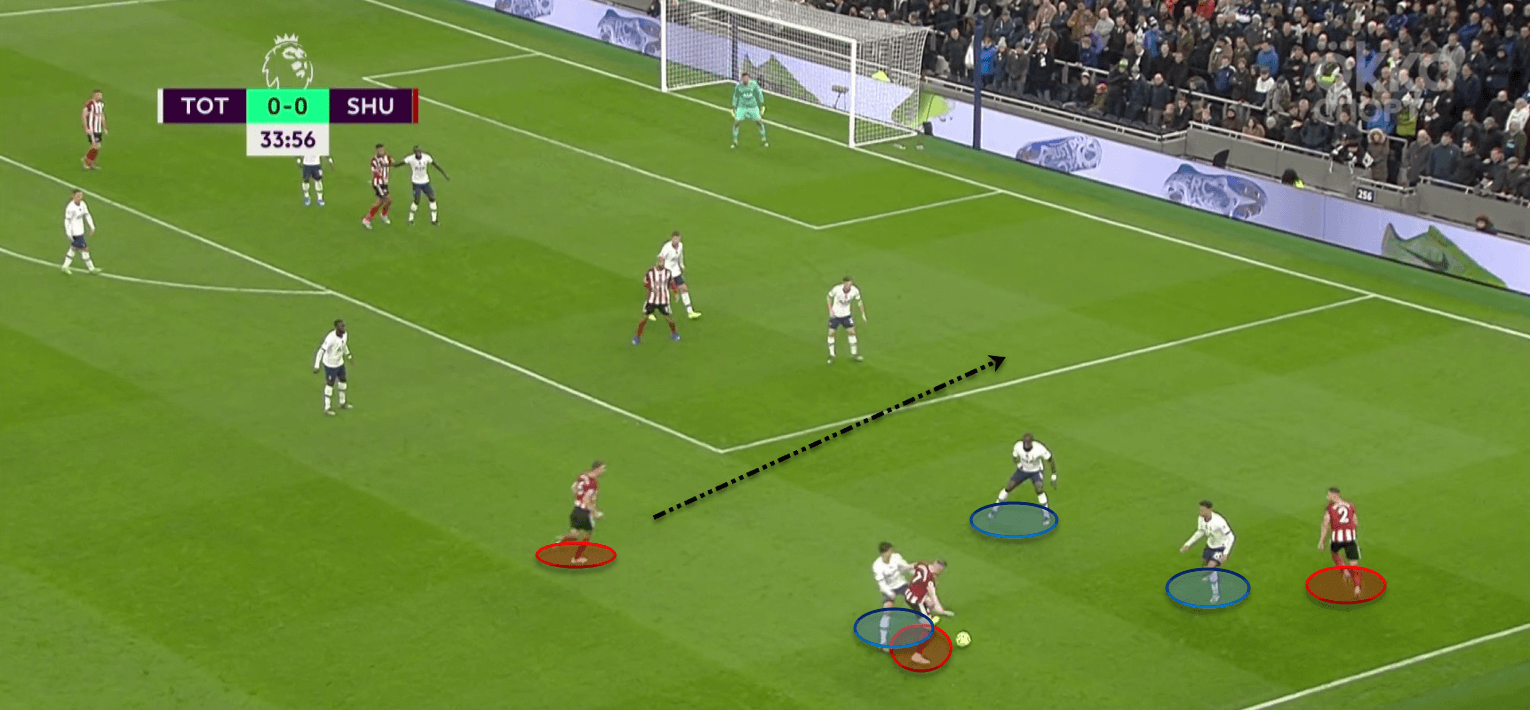
Thirdly, these runs are very effective, as there are usually two Sheffield players on the flank already (often midfielder and wing-back), so the centre-back becomes the third man making a run in a blindside zone of defenders. This also helps to create depth and get closer to the opposition goal as, again, their run in behind the defence is usually hard to track.
Last but not least, their presence in the penalty area poses a real threat, as Basham (6’2) and O’Connell (also 6’2) can provide solid options for crosses.
In this paragraph, I will take a closer look at how Sheffield is switching the direction of attack. Norwood is one of the best in the team passing-wise, he has a good passing range and can quickly make a switch from one flank to the other. However, I am going to focus on switching the flanks through normal passes. In the image below, Sheffield have an obvious numerical superiority on the right flank with Basham and Baldock up against one player. At the same time, Stevens is surrounded by four opposition players. Berge is dropping a little deeper and he gets the ball to the right flank. It is hard to see in the picture, but McBurnie is also dragging Aké out of his position, so then he (or other players) can make a run in behind.
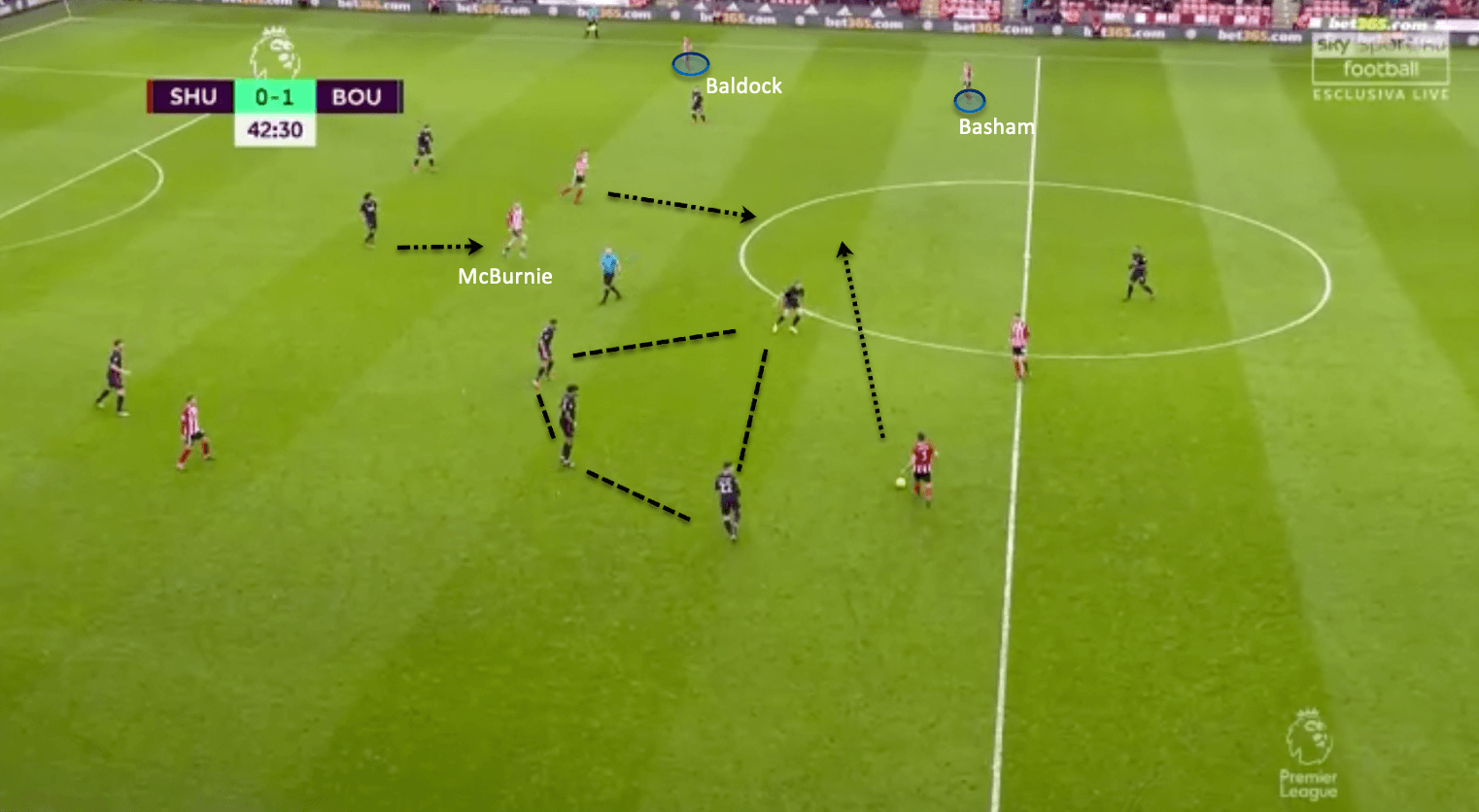
These are some of the main principles of Sheffield United in the attack, and in the next section, I will analyse their defensive organization.
Defensive structure
Sheffield United’s defence has been one of the key aspects of this team’s phenomenal season. They are second in the league in terms of conceded goals (25 goals conceded in 28 games) and seventh in terms of xGA(according to Understat). Meanwhile, Dean Henderson shares the third place with Ederson and Schmeichel in terms of clean sheets (all of them got 10). In this section, I am going to look at some of the things that allow this team to be so well-organised defensively.
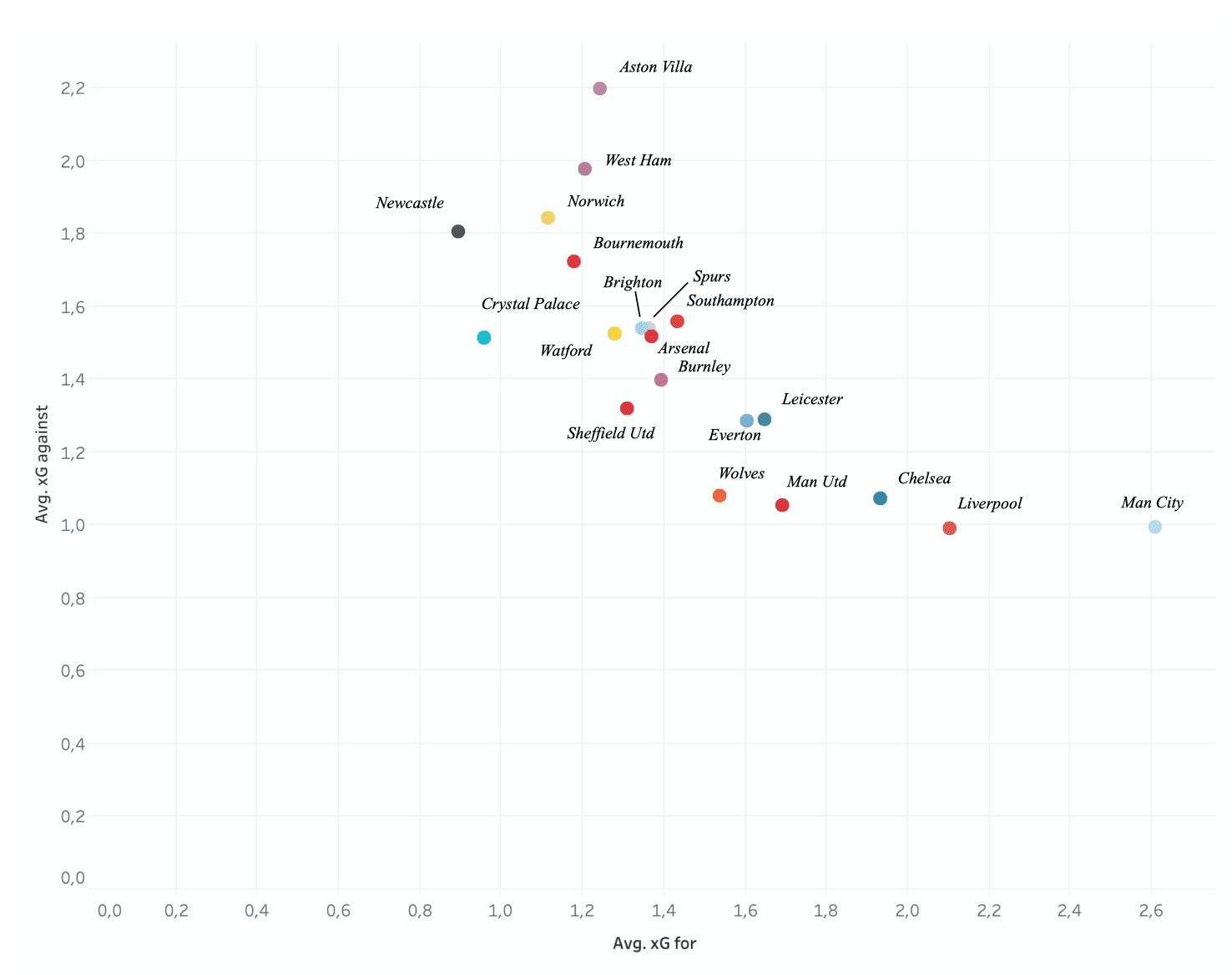
In previous sections of this analysis, I’ve looked at attacking patterns of Sheffield United, and one of the main ones has been Wilder’s usage of overlapping centre-backs, who are playing a big role in how Sheffield are playing from the back. The way Wilder set his team up offensively might seem risky and unreasonable because if Sheffield lose the ball, they would be exposed in transition.
They use a lot of players during their attacks, moreover, they use a lot of players down one flank. However, their way of playing doesn’t really benefit the opposition if the ball is lost.
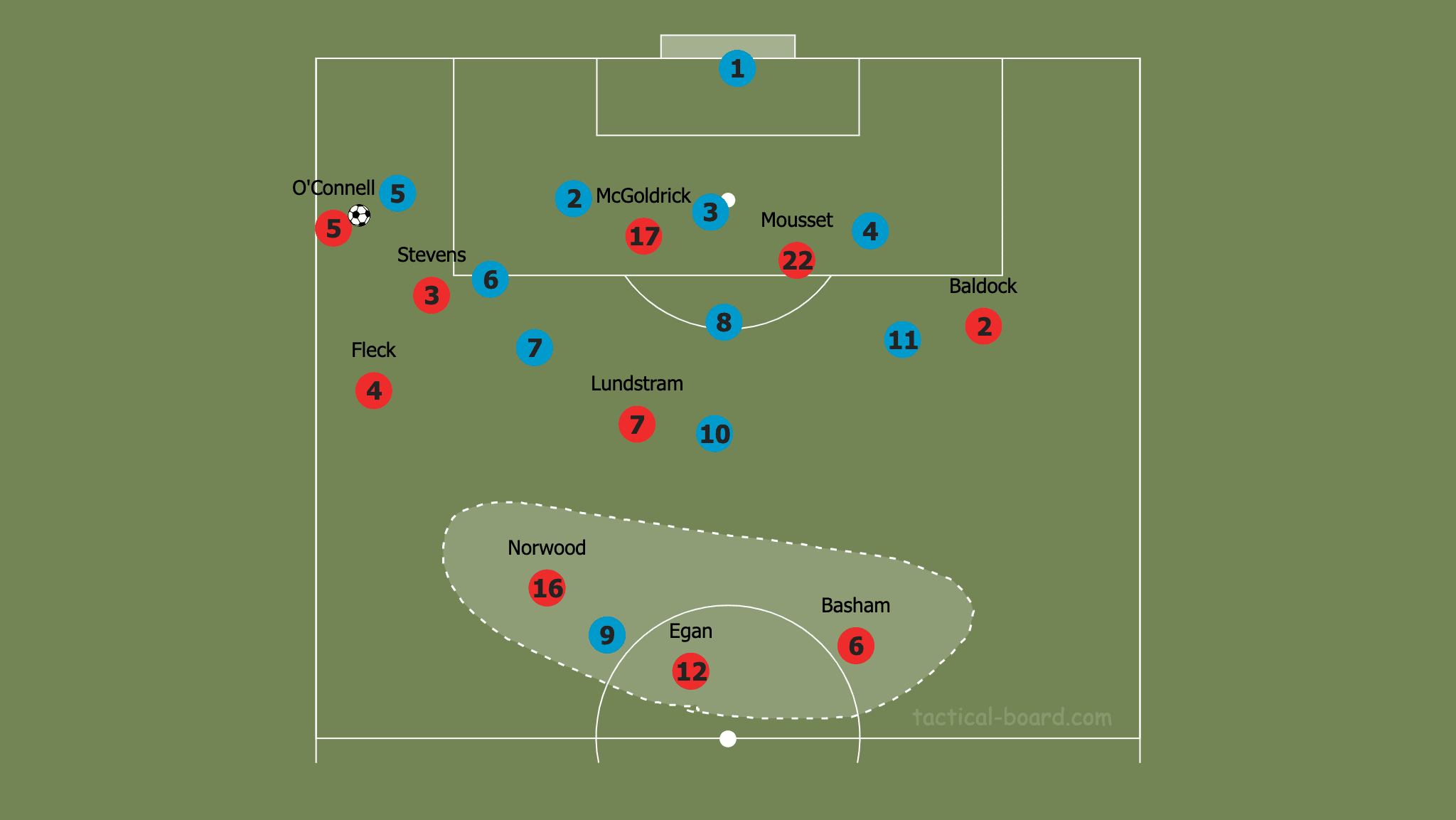
As you can see, if the opposition team is playing with one striker, then he would be isolated against a handful of Sheffield defenders. If one of the centre-backs (O’Connell in this example) pushes forward, then Norwood takes his place to close down the gap. Plus, the centre-back on another side (right centre-back in this example) is staying with Egan, so we get a back-three against one striker. Thus, even though it might seem that Sheffield are exposing themselves in a transition with the way they play, in reality, they are balanced in attacking and defensive numbers.
If the opposing team uses only one striker, then Sheffield might have more involvement from both, left- and right-sided, centre-backs. The side centre-back who is staying in the defensive line (like Basham in the example above) can be crucial when it comes to switching the play. As we know, both Basham and O’Connell can drive forward with the ball, and that is exactly what they are doing when switching the play from one flank to the other.
Having the ball on one side of the pitch with so many players paves the way for great counter-pressing opportunities. Sheffield have three, four, sometimes five players to immediately press the opposition after the switch of possession. This helps to stop any signs of counter-attacks right in the beginning.
However, if the opposing team manages to bypass Sheffield’s counter-press, then the whole team rolls back and forms a middle or low block(low block against the bigger teams). They use 5-3-2 formation when defending, like in the image below against Manchester City. The forwards form the first line of defence, the three midfielders are positioned above the backline of defenders, and wing-backs trackback and become fullbacks together with the three central defenders. Wing-backs take on opposition full-backs or wingers, players near the touchline in general(in this case, City using wide wingers in their system, so Baldock is up against Bernando Silva).
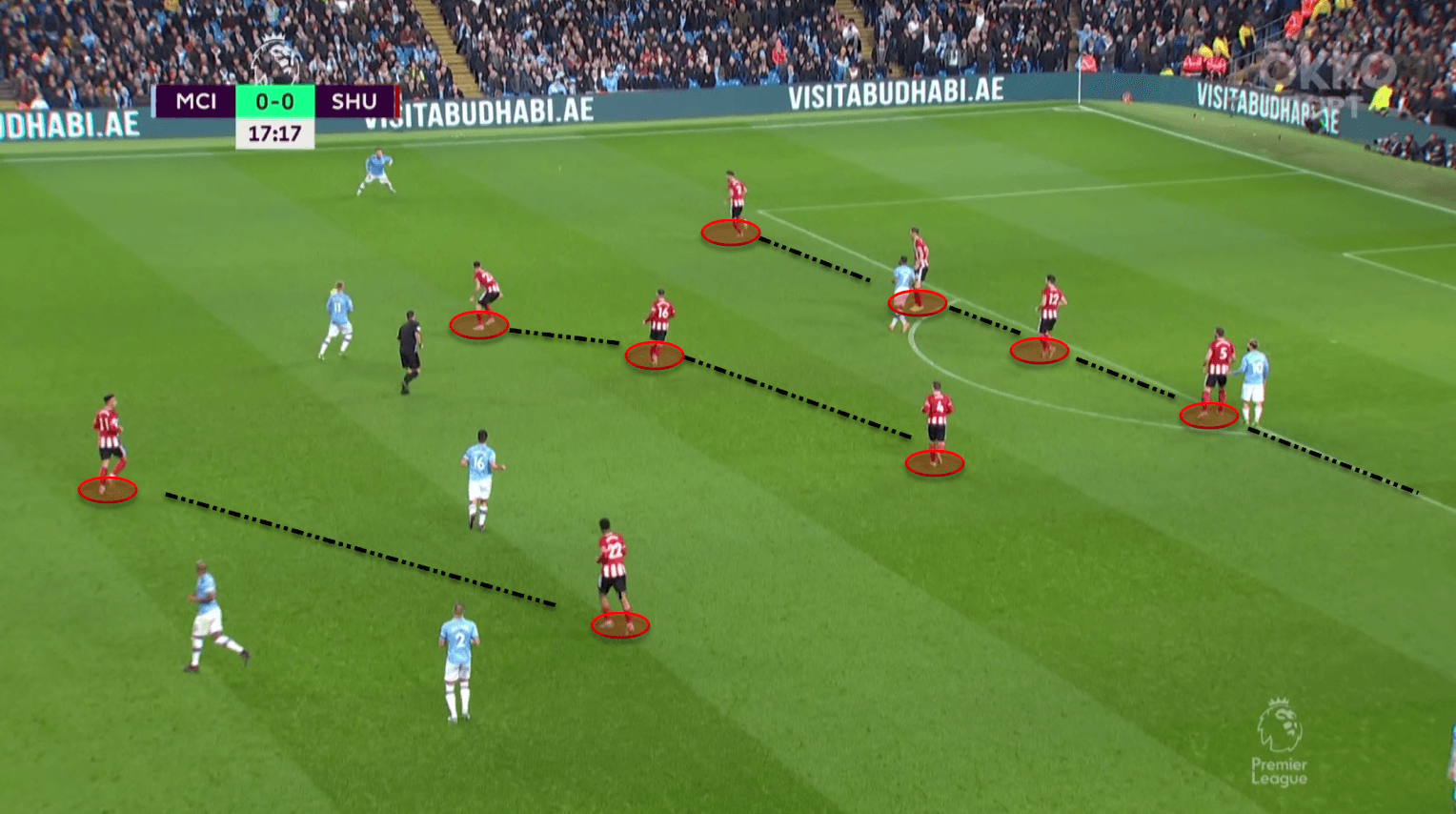
In the low block like against Manchester City the right and left midfielders mark players in half-spaces, and when the ball gets to the wide players, they help wing-backs by creating 2v1 on the flank. In the middle block the right and left centre-backs can step out of the line to mark and tackle players in half-spaces, while other defenders narrow down to close the gap. Midfielders, in this case, operate a little bit higher and cover opposition’s full-backs.
Due to having five players at the back plus getting the midfielders in their 18-yard box too, it is basically impossible to outnumber them in the penalty area. All the defenders are tall and good in the air, and even if they let the cross come in, most of the time it is a safe clearance.

Regarding their pressing, all players are physically hardy, tenacious and aggressive and their volume of defensive actions is enormous.
As was mentioned, centre-backs cut off any passes in front of their defensive line, especially in half-spaces, midfielders are very flexible in terms of how they are positioned and who are their markers. Norwood can get higher up the pitch and help forwards, he also situationally gives cover for two other midfielders.
Midfielders help wing-backs mark the opposition wide players, other two midfielders(Norwood and the other midfielder who is far from the flank where the ball is) cover the central areas. Forwards mark opposition centre-backs, and when the opposing team manages to get up the pitch, they switch to marking midfielders(oftentimes defensive midfielders).
The image below is a great example of Sheffield’s defensive shape. You can see several patterns that I mentioned above. Fleck is marking opposition full-back, Stevens is marking the wide player, and O’Connell steps out the defensive line to mark his player. Also, forwards are marking defenders and defensive midfielder, and other two midfielders(Norwood and Lundstram) are covering the centre.

The stamina, aggressiveness and great chemistry make Sheffield United one of the best teams in the Premier League defensively. Purchasing Berge and Retsos makes their defensive matters even better, and their run for Europe becomes more and more interesting.
Conclusion
Bramall Lane saw the Premier League football for the first time since the 2006/07 season, and there is absolutely no sign that they will go down again soon. On the contrary, brilliant management, Chris Wilder’s tactics and a unique playing system allowed Sheffield to compete for the higher than expected positions in the league in their first season after securing the promotion. With the right investments that have already been made and hopefully will be made in the next transfer window, Sheffield United and their Gaffer have the real chance of establishing themselves in the Premier League for years ahead. Moreover, just like any other team, they have a big room for improvement and this season surely will not be the last one where they are trying to get European football. All we have to do is watch this excellent team conquer the hearts of all neutral fans in England and keep making their wildest dreams come true.




Comments